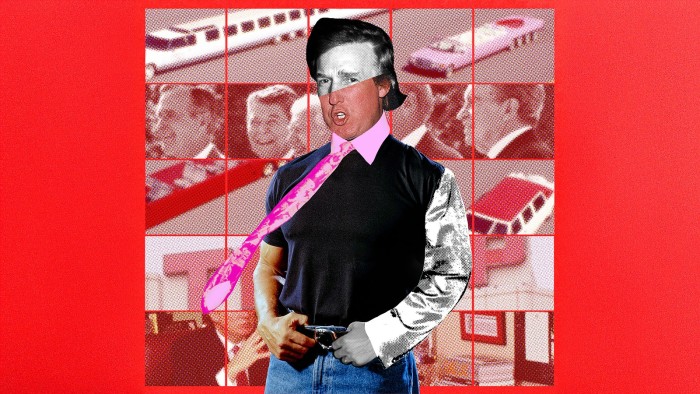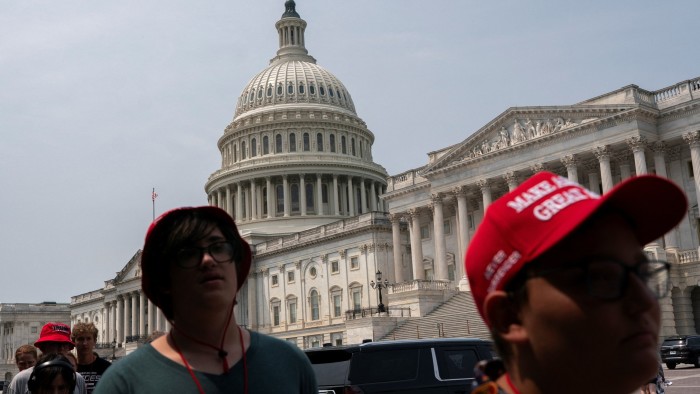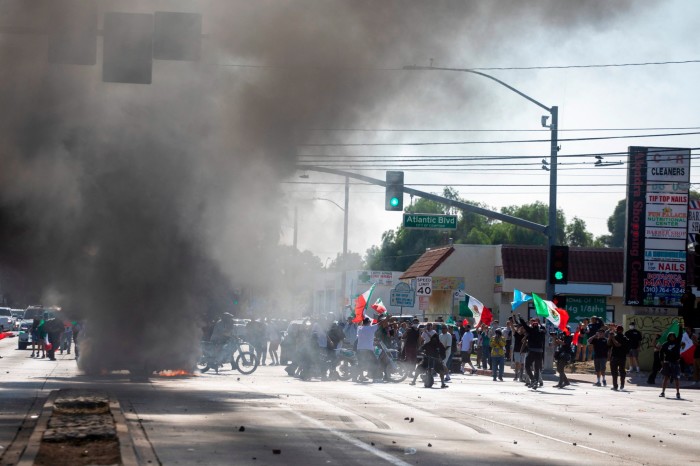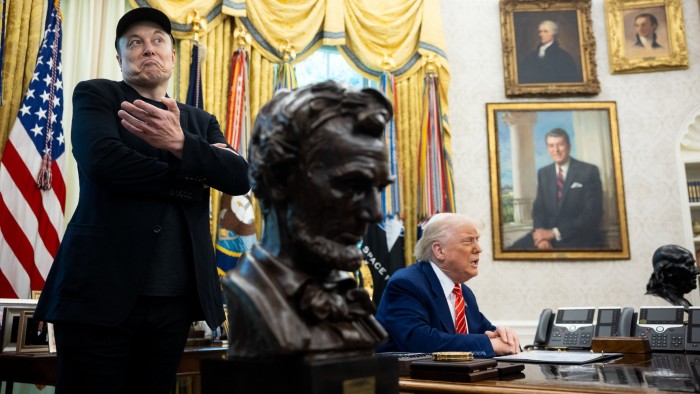How the ’90s shaped Donald Trump’s politics of national despair

Donald Trump is one of the world’s most recognisable symbols of wealth. Making himself synonymous with prosperity has been one of the secrets to his success. To many Americans, Trump has come to represent something like money itself. But, as his critics often remind us, he also represents the other side of the balance sheet: rampant debt, financial trickery, insolvency and bankruptcy.
Trump represents capitalism not just in its growth phase, but also in chaos and crisis. And, on some level, he knows that. In 2016, he declared himself the “king of debt” and, in 1992, after his brush with ruin, he told New York magazine: “I was the cover boy, I was the leader of the depression,” making his own reversal of fortune emblematic of that era’s downturn. He was on to something. That mini “depression” of the early 1990s was one of the first signs of a wider crisis of liberal democracy and free-market capitalism that gave birth to what I’ve called a politics of national despair.
Understanding Trump’s political success and possible trajectory is the great preoccupation of our times. Endless hours of debate have been given over to parsing what Trump “really believes” or what “Trumpism” really consists of. But the best way to understand Trump is to look at his brush with failure during this earlier moment of American crisis — and the way in which he would later take up the politics of national despair for his own ends.
Trump’s life provides an uncanny microcosm of the trajectory of the country: first, in the 1980s, the rather tacky, fabulous success made possible by financial chicanery, and then the downfall, the ignominious bankruptcies and near liquidation of his assets. In the 1990s, Trump’s outlook on life became more angry, dour, paranoid. So did that of the United States.
The early 1990s might have been Trump’s low point. His boardwalk empire in Atlantic City looked like it was falling into the sea. In 1991, the Trump Taj Mahal Casino filed for bankruptcy. By the following March, his two other casinos had done the same. Trump holdings were on the hook for $3.4bn in loans, nearly $900mn of which were personally guaranteed. He was losing all the trappings that had made him the avatar of glitzy success through the 1980s. He lost his yacht, his airline and half his stake in The Plaza Hotel. In 1987, at the height of his fame and fortune, he had released The Art of the Deal, a work of self-praise that cemented his reputation as a master of capitalism. But by 1990, Trump was in a more Darwinian frame of mind. The sequel was entitled Surviving at the Top, a more irritable and bitter volume. In it, Trump gripes about his recent divorce from Ivana Trump, but that was already all over the tabloids. The US media had once helped build up his brand, now they were the enemy, “simply a business of distortion and lies”. In 1991, Trump would threaten to sue the New York Post, once his great friend and ally, for “defamatory statements”. That same year, his publisher re-released the book as The Art of Survival — he could no longer be said to be on top.
How did it all go wrong? Trump was a one-man speculative bubble. As the economist Hyman Minsky noted at the time, he was an example of “Ponzi financing”. So long as the market value of his assets appreciated faster than the interest rates, he was fine. The actual cash flows didn’t matter. To service his debts, Trump simply borrowed more against an ever-expanding universe of assets. He bought more so he could borrow more. And, for a time, people lined up to lend.
Then the crash came: the real estate bubble that had steadily inflated through the 1980s finally burst, and the banks and bondholders who once believed the hype that anything with the Trump name on it would always appreciate became markedly less open-handed. They demanded what was, in essence, a massive margin call — they demanded collateral — and so Trump was forced to restructure. In the fall of 1991, he appeared before Congress with a gloomy message, “I truly feel that this country right now is in a depression. It’s not a recession. People are kidding themselves if they think it’s a recession.” This was characteristic hyperbole, but there was something to it. Trump was not the only highly leveraged entity unable to digest a decade of bad loans. Banks were collapsing and ordinary people were affected too. Personal bankruptcies and home foreclosures hit a record high in the recession. Trump’s business travails were spectacular, but, in another sense, quite ordinary. He’d made it big in boom times and now he was facing ruin as the music stopped.
If there wasn’t technically a depression, the country had certainly woken up in a depressed mood. There was a marked vibe shift from the sunny optimism of the Reagan ’80s. In 1992, when Francis Fukuyama announced an End of History, where liberal democracy and free-market capitalism had emerged triumphant, the idea already looked a little shaky. It was an election year and political observers were picking up on a swell of discontent that they called “voter rage”. Others talked about a growing wave of “outsiderism” and “populism”. Polls and surveys picked up broad and deep frustration with representative government, particularly the combination of political and economic elites that seemed to rig the game in their favour. Newly popular talk-radio shows buzzed with disgruntled callers, egged on by angry hosts. Grassroots organisations, like THRO (Throw the Hypocritical Rascals Out) sprang up calling for term limits for elected officials. People seemed not to want to simply vote in the opposition, but to reject the whole system.
An early bellwether for this darker national mood was in Louisiana, where the boom times of the 1980s never really took hold in the first place. While the rest of the country prospered, the collapse of oil prices mired the state in an extended downturn. The neo-Nazi and former Klansman David Duke had fractured a fragile GOP coalition and was mounting an insurgency in the state against the mainstream of the Republican party. Despite Ronald Reagan, President George HW Bush and the entire RNC coming after him, Duke became a state legislator in 1989 and won primaries to become the de facto Republican candidate for senator in 1990 and governor in 1991. Although he lost those statewide races by significant margins, he was winning majorities among white voters, who had seen the sources of their prosperity disappear and were inclined to blame “coddled” minorities.
Duke’s voters either didn’t mind or else secretly liked what he was about. To them, he represented the rejection of a failed status quo and a radical move towards something else. For Duke, politics was a zero-sum race war: whites needed a champion against “ungrateful Blacks” taking advantage of welfare and affirmative action, Latinos swarming over the border and, in a lower key on the campaign trail, Jews who controlled all of it through the media and international finance. The state and national Republican party frantically tried to stop Duke and failed. The country watched with horror — but also rapt curiosity — as a man who once picketed his college campus in a Nazi uniform and publicly denied the Holocaust became a national figure.
Some malcontents at the margins of politics, who called themselves “paleoconservatives” to distinguish themselves from their neoconservative rivals, watched Duke’s emergence with hope rather than fear. One was the radical libertarian “anarcho-capitalist” economist Murray Rothbard, who had been cast out of the Cato Institute he had helped found. Rothbard, the child of Russian Jewish immigrants from the Bronx, watched the spectacle of the media and mainstream politicians frantically trying to beat back Duke with glee. He saw in the Duke phenomenon a potentially successful type of future politics, if it could be harnessed properly, by the right candidate.
Rothbard outlined his idea in a 1992 essay, “Right-Wing Populism: A Strategy for the Paleo Movement”, calling for “charismatic political leadership” by someone with the ability to “short-circuit the dominant media and intellectual elites”, and to “rouse the masses of people against the elites that are looting them”. This would be accomplished through relentless attacks that would expose “the corrupt ruling elites and how they benefit from the existing system, more specifically, how they are ripping us off”, Rothbard wrote. “Ripping the mask off elites,” he added, “is ‘negative campaigning’ at its finest and most fundamental.” In office, the populist demagogue would then institute a programme of tax cuts, blowing up the federal bureaucracy, affirmative action and the “civil rights structure”. The cops would be “unleashed” on criminals and vagrants. And he would pursue an “America First” economy: “Come home, America. Stop supporting bums abroad. Stop all foreign aid, which is aid to banksters and their bonds and their export industries. Stop globaloney, and let’s solve our problems at home.”
Another writer, a cantankerous newspaper editor and former Senate aide named Samuel T Francis mused, “It’s possible that future historians will look back on the Louisiana gubernatorial election of 1991 as a turning point in American history.” For Francis, Duke was a sign of a coming “middle American revolution” where the dispossessed would throw off the rule of the “globalist elite” and establish a new assertive American nationalism behind a “Caesarist . . . populist-based presidency”.
In 1991, Duke was already amping up for a presidential run, facing George HW Bush in the ’92 Republican primaries. The discontented intellectuals of the far right were not the only ones taking notice. Donald Trump was too. On Larry King Live in late 1991, Trump opined: “It’s anger. I mean, that’s an anger vote. People are angry about what’s happened. People are angry about the jobs. If you look at Louisiana, they’re really in deep trouble . . . If David Duke runs, David Duke is going to get a lot of votes.” But Duke was never a real contender. He had too much baggage and wasn’t taken entirely seriously by the public, who viewed him as a freak or curiosity. Instead it was another figure, in the heart of Washington’s conservative establishment, who would pick up the banner. Trump called it on that same Larry King programme: “Pat Buchanan — who really has many of the same theories, except it’s in a better package,” he said. “Pat Buchanan is going to take a lot of votes away from George Bush. So if you have these two guys running, or even one of them running, I think George Bush could be in big trouble.”
Patrick J Buchanan was one of America’s most prominent conservative commentators, an adviser to the Nixon and Reagan administrations, and a constant presence on cable TV. He had grown dissatisfied with the direction of the American right, which he felt had been taken over by “neocon” interlopers: ex-liberals and leftists who had joined the movement late and whose real loyalty, he felt, was to Israel. Buchanan returned to an older form of conservatism. He believed in America First, that “non-European” immigrants could not be assimilated. Witnessing the deindustrialisation of the heartland, he’d soured on Reagan’s free-trade faith and wanted to protect American industry. Supported by his friends and advisers, Francis and Rothbard, Buchanan wanted to take back the party — and then the country. To do this, he would tap into previously neglected constituencies. “The greatest vacuum in American politics,” he told The Washington Post, “is to the right of Ronald Reagan.”
Launching his primary campaign in New Hampshire, Buchanan inveighed against Bush: “He is yesterday and we are tomorrow. He is a globalist and we are nationalists. He believes in some Pax Universalis; we believe in the Old Republic. He would put American’s wealth and power at the service of some vague New World Order; we will put America first.” But in the end, Buchanan could only damage, not defeat, the incumbent president. The real threat would come from a candidate outside the two main parties.
In February 1992, On another episode of Larry King Live, Texas billionaire Ross Perot announced he would run for president if volunteers in all 50 states put him on the ballot. A former Republican donor, Perot had built a fortune with his company Electronic Data Systems, a computing services firm that grew on massive contracts from the federal government.
In the years since he sold his company to General Motors, he’d become a regular on the talk-show circuit, railing in his Texan twang against government incompetence, waste, corruption, trade deficits and an out-of-control national debt. He was also a champion of the POW/MIA movement, claiming that there were living American prisoners still being held by communist regimes in south-east Asia and that US government bureaucrats conspired to keep silent about it. His appearance on the show prompted a deluge of callers to Perot’s Dallas headquarters. Volunteers fanned out across the country with petitions to get him on the ballot.
What was the actual content of Perot’s billionaire populism? The idea was that he’d return the country to its rightful owners. “The ruling class has lost touch with the American people. They have lost touch because they swim in a world of privilege, power and wealth,” Perot said. “The American people can’t afford it themselves, so I’m buying the country back for them.” It didn’t seem to matter that he was light on specific policies: his people liked the idea that he might fix things above all. “We’re not interested in detailed positions. Everybody has detailed positions. Nobody implements them,” Perot said on NBC’s Today show. “Taking action in Washington is apparently an unnatural event. But that’s what people want. If they put me there, that’s what we’ll do. We’ll have action.” He liked to say, “The United States is the largest and most complex business enterprise in the history of mankind.” For Perot, as for Trump decades later, being a proven winner at business was the best proof of suitability to lead the country.
One idea Perot floated was to remove one of Congress’s core constitutional powers: its ability to raise taxes. Since lobbies and special interests had captured the representative system, Perot said he would institute “electronic townhalls”, an experiment in direct democracy that would poll the people, live. He had essentially conjured up social media. Critics pointed out that such digital plebiscites could be easily manipulated by the rich and powerful. Some pointed to even darker potentials. “If the country can be run like USA Inc, you know, with a real can-do guy, there’s a whiff of fascism to that, I think,” the columnist Christopher Hitchens opined. But the public wasn’t interested in what critics had to say. “We’re staging a bloodless coup against the government,” one volunteer told the press. Perot’s still-unofficial candidacy was on fire. By June, he was polling at 39 per cent of the vote, leading the major party candidates, Bush and Bill Clinton.
It did not last. Perot’s candidacy collapsed just a month later under the weight of negative news stories, his frustration with the process and his own paranoia. Citing worries about Republican dirty tricks, he dropped out of the race in July, disappointing and angering his legions of supporters and volunteers. When he suddenly returned to the campaign trail in October, he could not recapture the momentum. Still, on election day, he managed to win 18.9 per cent of the popular vote, the biggest percentage won by a third-party candidate since Teddy Roosevelt’s 1912 run.
With Clinton’s victory, the upswell of populist discontent looked to be contained in a moderate vessel. Globalisation, free trade and democratic capitalism seemed to have come out on top. The coming decade saw Nafta passed, finance further deregulated, the coming of the World Trade Organization, and apparent prosperity. America seemed peaceful, but the politics of national despair were still just below the surface. Economists have noticed something strange about the rebound from the early ’90s recession, labelling it a “jobless recovery”. They’ve also talked about something called “job polarisation”: America seemed to be creating both menial and well-paid, high-skilled jobs, but the jobs in between were disappearing.
Occasionally, the discontent boiled over. From 1995, the Republican Speaker of the House Newt Gingrich rechannelled Perot’s anti-system energy into the GOP with a confrontational hyper-partisanship. Massively popular talk-radio hosts like Rush Limbaugh pushed wild conspiracy theories about Clinton. One dedicated listener and consumer of conspiracy literature, Timothy McVeigh, witnessed the government’s deadly raid on the Branch Davidian compound in Waco, Texas, and decided to avenge it with an act of spectacular terror. In 1999, leftwing protests against the WTO in Seattle drew the praise of Pat Buchanan.
Trump also bounced back in the late ’90s. By some measures, he was even richer than he had been in the ’80s. But he also could not quite shed the bitterness of those dark years. His 1997 book The Art of the Comeback declared his new ethos: “Get Even: During the bad times, I learned who was loyal and who wasn’t. I believe in an eye for an eye. A couple of people who betrayed me need my help now, and I am screwing them against the wall! I am doing a number . . . and I’m having so much fun.” In 1999, Trump announced a run for president on Perot’s Reform Party ticket. His opponent for the nomination was Buchanan, whom Trump now called a “Hitler lover”. And in his campaign book, The America We Deserve, he wrote that his “remarks about Hitler suggest Buchanan would adopt a foreign policy today that is absolutely guaranteed to encourage the most oppressive, anti-American dictators in our own times”.
Trump was running to Buchanan’s left: in his 2000 campaign, there was economic nationalism, immigration restrictionism, a general scepticism of foreign intervention, but also moderation on social issues. Trump denounced hate crimes and supported universal healthcare. It didn’t work. The party fractured and Trump left in a huff. “The Reform Party now includes a Klansman, Mr Duke; a neo-Nazi, Mr Buchanan; and a communist, Ms [Lenora] Fulani,” he announced. “This is not company I wish to keep.” According to Buchanan, and his sister Bay, sometime in the 2010s Trump called out of the blue to apologise for his remarks.
When Trump announced his 2016 presidential bid, he leaned fully into the anger, resentment and despair he’d been watching brew since the early ’90s. By 2015, his chosen campaign book title was Crippled America. Now, Trump took an even more strident tone than Buchanan had decades before: America was being invaded, ripped off, poisoned. Duke endorsed Trump. Trump pretended he didn’t know who he was. The country had been through the financial crisis and the failed foreign adventures of the “War on Terror”. In 2016, Trump’s pessimistic message resonated and ultimately broke through.
The fracturing of the Soviet Union in 1991 ended socialism’s dream of limitless human progress and shared abundance. Its opponent — free-market capitalism and liberal democracy — looked triumphant. But by 2016 the liberal project of global prosperity and endless growth was, in less dramatic ways, beginning to show cracks of its own. Those cracks have since split wide open.
There seem to be boundaries that cannot be transcended without an irreparable sense of loss: race, nation, gender. For many, capitalist society doesn’t look like a fair competition among equal players. Instead, it’s a bitter war of all against all. There is not enough to go around, be it through immigration, or trade agreements, welfare or affirmative action. Others take what is not rightfully theirs and corrupt politicians let it happen. Everything is rigged. There is no ever-expanding horizon of mutual benefit and exchange; the politics of national despair sees only hard limits and brutal struggles.
During his farewell address in 1989, Reagan summoned the image of America as a “shining city on a hill”, a “tall, proud city built on rocks stronger than oceans, wind-swept, God-blessed and teeming with people of all kinds living in harmony and peace; a city with free ports that hummed with commerce and creativity. And if there had to be city walls, the walls had doors and the doors were open to anyone with the will and the heart to get here.” Today, thanks to the success of Trumpism, new walls are being built, and more and more of the world is finding the doors to America are firmly shut.
There is one vision of American capitalism that suggests it can provide shared abundance. Another demands the restraint of corporate power and redistribution. Both of those offer a horizon of possibilities that is different from what Trump learnt as he built his business and political empire, and what he now represents. His vision is that scarcity and inequality are permanent. It embraces despair. It says there is no possibility beyond this brutal arrangement. And, in that judgment, it seems realistic and honest. In fact it is delusional. In place of shared growth and prosperity, Trumpism offers only endless acquisitions and hostile takeovers. Until, of course, the bubble bursts once more.
John Ganz is the author of “When the Clock Broke: Con Men, Conspiracists and the Origins of Trumpism”
Find out about our latest stories first — follow FT Weekend Magazine on X and FT Weekend on Instagram






